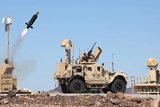Lockheed Martin bags $3.2 billion US Air Force contract for JASSM and LRASM
A B-1B Lancer carrying an AGM-158 Joint Air-to-Surface Standoff Missile. (Photo: US Air Force / Wikimedia Commons)
The US Air Force had awarded Lockheed Martin with a US$3.2 billion sole-source contract to produce joint air-to-surface standoff missiles (JASSM) and long-range anti-ship missiles (LRASM).
The contract focused on Lot 22 JASSM and LRASM and Foreign Military Sales (FMS) missiles for Japan, the Netherlands, Finland and Poland. As reported by Reuters, in May 2024, Poland signed a reported $735 million contact with the US for the supply of JASSM-ER (extended-range) missiles.
JASSMs – one of Lockheed’s first cruise missiles – are conventional, air-launched missiles, designed for the US Air Force and international allies, while LRASMs are precision-guided, long-range anti-ship missiles, designed to meet the demands of the US Air Force and Navy.
On 16 September 2024, Lockheed Martin unveiled its AGM-158 XR cruise missile concept, which it claimed would offer increased standoff attack range. The XR missile would also be compatible with the same platforms that deploy the JASSM and LRASM, including the F-35 Lightning II combat aircraft.
Related Equipment in Defence Insight
More from Air Warfare
-
![How do we detect and defeat enemy drones?]()
How do we detect and defeat enemy drones?
Learn about the portfolio of sensors and effectors for the complete counter-UAS mission at Raytheon, an RTX business.
-
![BAE Systems lauds counter-UAS drone progression with live fire trials]()
BAE Systems lauds counter-UAS drone progression with live fire trials
The US-based tests successfully demonstrated the first live trial of a precision guided missile from a modified TRV-150 drone which destroyed both aerial and ground targets.
-
![Kratos Defense makes European CCA push with Airbus partnership]()
Kratos Defense makes European CCA push with Airbus partnership
Kratos’ XQ-58A Valkyrie will be equipped with an Airbus-made mission system to be offered as a ‘European’ collaborative combat aircraft option to the German Air Force.
-
![Anduril’s Barracuda-100M completes latest successful test flights]()
Anduril’s Barracuda-100M completes latest successful test flights
The munitions variant of the Barrauda-100 autonomous air vehicle is being tested for the US Army’s High-Speed Manoeuvrable Missile (HSMM) testbed programme, with further flight tests expected in 2026.






















